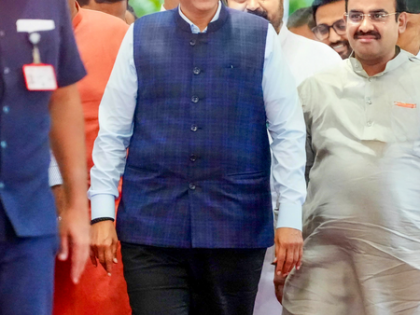Maharashtra Cabinet Approves Initiatives Aligned with Sustainable Development Goals
The Maharashtra Cabinet has sanctioned a series of proposals aimed at advancing economic, infrastructural, and social development, with significant implications for achieving multiple Sustainable Development Goals (SDGs).
Fostering Economic Growth and Innovation (SDG 8 & SDG 9)
The cabinet’s decisions underscore a commitment to promoting sustained, inclusive, and sustainable economic growth, full and productive employment, and decent work for all (SDG 8), alongside building resilient infrastructure and fostering innovation (SDG 9).
- Maharashtra Startup, Entrepreneurship and Innovation Policy 2025: This policy is designed to cultivate an ecosystem that supports entrepreneurship and innovation. By focusing on skill development, it directly contributes to SDG 8 (Decent Work and Economic Growth) and SDG 9 (Industry, Innovation and Infrastructure).
- Nagpur Weavers’ Cooperative Spinning Mill Support: A grant of INR 50 crore was approved for 1,124 workers, funded by the sale of mill land. This measure provides direct financial relief, aligning with SDG 1 (No Poverty) and SDG 8 by supporting workers in a transitioning industry.
Enhancing Infrastructure and Sustainable Land Use (SDG 9 & SDG 11)
Key approvals focus on building resilient infrastructure and making human settlements inclusive, safe, resilient, and sustainable (SDG 11).
- New Freight Corridor Development: Approval was granted for a new freight corridor connecting Vadhavan Port to the Hindu Hriday Samrat Balasaheb Thackeray Maharashtra Samruddhi Mahamarg. This major project is a direct investment in SDG 9, enhancing logistical infrastructure to support industry and trade.
- Sustainable Land Management Policy: A policy for the disposal of unviable government land was sanctioned. This promotes efficient land use, a core component of SDG 11, by repurposing small, inaccessible, or landlocked plots.
- MSRTC Land Monetisation: The Maharashtra State Road Transport Corporation received approval to monetise surplus land for commercial use. This strategy generates revenue for public transport improvements, contributing to sustainable infrastructure under SDG 9 and SDG 11.
Promoting Social Welfare and Reducing Inequalities (SDG 1, SDG 3, SDG 10)
The government has also reinforced its commitment to social inclusion, health, and well-being, directly addressing key social SDGs.
- Support for Leprosy Patients: The monthly grant for non-government organisations assisting leprosy patients was tripled from INR 2,000 to INR 6,000. This significantly enhances support for a vulnerable group, aligning with SDG 3 (Good Health and Well-being) and SDG 10 (Reduced Inequalities).
- Worker Welfare: The financial grant for weavers addresses economic hardship, contributing to SDG 1 (No Poverty) and SDG 10 by providing a safety net for workers facing economic uncertainty.
Analysis of Sustainable Development Goals (SDGs) in the Article
-
Which SDGs are addressed or connected to the issues highlighted in the article?
The article discusses several government proposals in Maharashtra that connect to multiple Sustainable Development Goals. The key SDGs addressed are:
-
SDG 1: No Poverty
The decision to provide a grant to workers of a cooperative spinning mill is a direct social protection measure aimed at alleviating financial hardship, which is central to SDG 1.
-
SDG 3: Good Health and Well-being
The increased financial support for NGOs working with leprosy patients directly contributes to enhancing healthcare and welfare for a vulnerable group, aligning with the goals of SDG 3.
-
SDG 8: Decent Work and Economic Growth
The article highlights several initiatives aimed at fostering economic progress. The new Startup and Innovation Policy is designed to promote entrepreneurship and skill development. Additionally, the grant for textile workers supports employment in a key sector.
-
SDG 9: Industry, Innovation, and Infrastructure
This goal is prominently featured through the approval of a new freight corridor to improve connectivity and the adoption of a policy to foster innovation and support entrepreneurship.
-
SDG 10: Reduced Inequalities
By increasing the grant for organizations supporting leprosy patients, the government is taking a step to support a marginalized and vulnerable community, thereby addressing inequalities.
-
SDG 11: Sustainable Cities and Communities
The land reform measures, including policies for disposing of unviable government land and monetizing surplus land for commercial use, relate to sustainable urban planning and land resource management.
-
-
What specific targets under those SDGs can be identified based on the article’s content?
Based on the initiatives described, the following specific SDG targets can be identified:
-
SDG 8: Decent Work and Economic Growth
- Target 8.3: “Promote development-oriented policies that support productive activities, decent job creation, entrepreneurship, creativity and innovation…” This is directly addressed by the “Maharashtra Startup, Entrepreneurship and Innovation Policy 2025,” which is designed to “encourage skill development, promote entrepreneurship, and support innovation.”
- Target 8.5: “By 2030, achieve full and productive employment and decent work for all…” The grant for the “1,124 workers of the Nagpur Weavers’ Cooperative Spinning Mill” is a measure to support employment and provide financial security to workers in the textile sector.
-
SDG 9: Industry, Innovation, and Infrastructure
- Target 9.1: “Develop quality, reliable, sustainable and resilient infrastructure…to support economic development and human well-being…” The approval for the “development of a new freight corridor linking Vadhavan Port…to the…Maharashtra Samruddhi Mahamarg” is a clear example of developing infrastructure to boost economic activity.
- Target 9.b: “Support domestic technology development, research and innovation…” The adoption of the “Maharashtra Startup, Entrepreneurship and Innovation Policy 2025” is a policy measure aimed at supporting domestic innovation.
-
SDG 10: Reduced Inequalities
- Target 10.2: “By 2030, empower and promote the social, economic and political inclusion of all, irrespective of…disability…or other status.” The decision to “raise the monthly grant for non-government organisations working with leprosy patients” is a targeted action to support a vulnerable group and promote their social inclusion.
-
SDG 11: Sustainable Cities and Communities
- Target 11.3: “By 2030, enhance inclusive and sustainable urbanization and capacity for…sustainable human settlement planning and management…” The new “policy for disposing of unviable government land” and allowing the transport corporation to “monetise surplus land” are actions related to efficient and sustainable land use management within communities.
-
-
Are there any indicators mentioned or implied in the article that can be used to measure progress towards the identified targets?
Yes, the article mentions several direct and indirect indicators that can be used to measure progress:
-
For SDG 8 and 9 (Innovation and Entrepreneurship):
The primary indicator is the adoption of the “Maharashtra Startup, Entrepreneurship and Innovation Policy 2025.” This is a policy-level indicator showing commitment to the target. Future progress could be measured by the number of startups created or supported under this policy, though these specific metrics are not in the article.
-
For SDG 9 (Infrastructure):
The indicator is the approval of the new freight corridor project and the finalization of its “Project planning and land acquisition.” This serves as a process indicator, marking a key milestone in the development of new infrastructure.
-
For SDG 8 (Decent Work):
The article provides a clear quantitative indicator: a “grant of INR 50 crore for 1,124 workers.” This directly measures the financial support provided to a specific group of workers.
-
For SDG 10 (Reduced Inequalities) and SDG 3 (Health):
A specific, measurable indicator is provided: the increase of the “monthly grant for non-government organisations working with leprosy patients from INR 2,000 to INR 6,000.” This is a quantitative indicator of increased financial support for a vulnerable group.
-
For SDG 11 (Sustainable Cities):
The indicators are the sanctioning of a “policy for disposing of unviable government land” and a “revised policy for commercial use of its additional holdings” by the MSRTC. These are policy-level indicators demonstrating action towards sustainable land management.
-
-
Table of SDGs, Targets, and Indicators
SDGs Targets Indicators Identified in the Article SDG 8: Decent Work and Economic Growth 8.3: Promote development-oriented policies that support entrepreneurship, creativity and innovation. 8.5: Achieve full and productive employment and decent work.
Adoption of the “Maharashtra Startup, Entrepreneurship and Innovation Policy 2025.” A grant of “INR 50 crore for 1,124 workers” of the Nagpur Weavers’ Cooperative Spinning Mill.
SDG 9: Industry, Innovation, and Infrastructure 9.1: Develop quality, reliable, sustainable and resilient infrastructure. 9.b: Support domestic technology development, research and innovation.
Approval for the “development of a new freight corridor linking Vadhavan Port” to the Samruddhi Mahamarg. Adoption of the “Maharashtra Startup, Entrepreneurship and Innovation Policy 2025.”
SDG 10: Reduced Inequalities 10.2: Empower and promote the social, economic and political inclusion of all, including persons with disabilities. Increase in the monthly grant for NGOs working with leprosy patients “from INR 2,000 to INR 6,000.” SDG 11: Sustainable Cities and Communities 11.3: Enhance inclusive and sustainable urbanization and capacity for sustainable human settlement planning. Sanctioning of a “policy for disposing of unviable government land.” Approval of a “revised policy for commercial use of its additional holdings” for the MSRTC.
SDG 3: Good Health and Well-being 3.8: Achieve universal health coverage, including financial risk protection and access to quality essential health-care services. Increased financial support for NGOs providing care to leprosy patients, indicated by the grant rising from INR 2,000 to INR 6,000.
Source: entrepreneur.com







